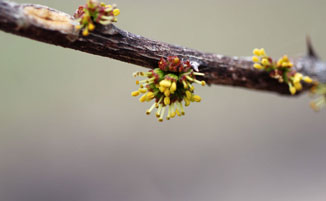PRICKLY ASH
|
 |
| File Size: 33 KB |
|
|
|
Zanthoxylum americanum P. Mill.
|
| Konza Prairie, Riley County, Kansas |
| Height: 20 inches to 16 feet |
| Family: Rutaceae - Citrus Family |
| Flowering Period: April |
|
| Also Called: | | Toothache tree. | | Trunks: | | Single, usually branched above middle, occasionally with branches near ground; crown irregular; bark dark-brown with light blotches, slightly furrowed on old trunks. | | Twigs: | | Rigid, glabrous, dark brown; usually 2 prickles at each node; prickles flat, broad-based, curved downward; leaf scars crescent-shaped or half-round; bundle scars 3; buds small, spherical, covered with red woolly hairs. | | Leaves: | | Alternate, odd pinnately-compound, deciduous, 2 to 10 inches long, aromatic; stalk about 1.2 inch long, pubescent; leaflets 5-11, nearly sessile, egg-shaped, 1.2 to 2.4 inches long, 3/5 to 1.2 inch wide; upper surface dark green, slightly rough, glandular-dotted; lower surface paler, veins pubescent; margin entire or finely toothed; tip abruptly pointed; base rounded or blunt. | | Flowers: | | Before leaves, inconspicuous, dioecious (male and female flowers on separate trees); staminate flowers in clusters of 2-10; stalk 1/8 to 1/6 inch long; calyx absent; petals 4-6, egg-shaped, 1/12 to 1/10 inch long, green; tip with red fringe; stamens 5-6; anthers small, yellow; pistillate flowers 2-10, in umbel-like clusters; stalks 1/8 to 1/6 inch long, calyx absent; petals similar to staminate; pistils 2-5; styles 1/12 inch long, green; stigmas spherical, green. | | Fruit: | | July-August; dense clusters; stalk 1/10 inch long; spherical, fleshy, about 1/5 inch in diameter, red, surface pitted, strongly spice-scented; seed oval, about 1/6 inch long, glossy black, finely pitted. | | Habitat: | | Rocky hillsides, open woods, woodland edges, roadsides, prairie ravine thickets; usually in calcareous soils. | | Distribution: | | East 3/5 of Kansas | | Origin: | | Native | | Uses: | | Native Americans steeped the bark and used the liquid as a wash for itching; took it for colds, fevers, and coughs; and rubbed on dog noses to enhance their scent. The inner bark was pounded and chewed, smoked, or packed around a tooth for toothaches. A poultice of crushed inner bark was applied for rheumatism. Young men sometimes used the fruits as perfume. | | Comments: | | Prickly ash forms thickets from underground, creeping stems. The common name "toothache tree" was given because oil derived from the fruit was used as a home remedy for toothaches. The wood is soft, porous, pale yellowish-brown. Greek xanthos "yellow" and xylon "wood". |
|
| Prickly ash pistillate flowers |  | | 37 KB | | Jefferson County, Kansas |
| | Prickly ash pistillate flowers |  | | 41 KB | | Jefferson County, Kansas |
| | Prickly ash staminate flowers |  | | 29 KB | | Konza Prairie, Riley County, Kansas |
| | Prickly ash |  | | 78 KB | | Konza Prairie, Riley County, Kansas |
| | Prickly ash |  | | 70 KB | | Jefferson County, Kansas |
| | Prickly ash |  | | 78 KB | | Konza Prairie, Riley County, Kansas |
| | Prickly ash fruit |  | | 70 KB | | Konza Prairie, Riley County, Kansas |
| | Prickly ash fruit |  | | 53 KB | | Konza Prairie, Riley County, Kansas |
| | Prickly ash fruit |  | | 79 KB | | Tallgrass Prairie National Preserve, Chase County, Kansas |
| | Prickly ash fruit |  | | 124 KB | | Tallgrass Prairie National Preserve, Chase County, Kansas |
| | Prickly ash |  | | 143 KB | | Tallgrass Prairie National Preserve, Chase County, Kansas |
| | Prickly ash bud and leaf scar |  | | 30 KB | | Konza Prairie, Riley County, Kansas |
| | Prickly ash buds |  | | 27 KB | | Konza Prairie, Riley County, Kansas |
| | |
|
|
|